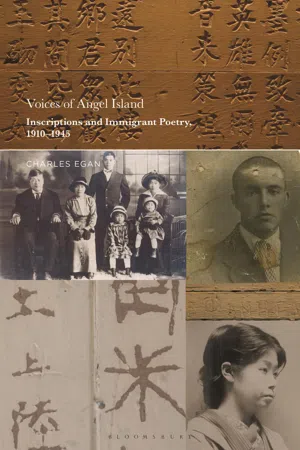![]()
1
Japanese Inscriptions, 1910–1940
First dream of the New Year — On the island I meet my picture bride
For Japanese immigrants, the so-called Gentlemen’s Agreement of 1907–1908 was the major factor governing immigration practices until 1924. Immigration of Japanese had been relatively free since 1894 under the terms of the US-Japan Treaty of Commerce and Navigation, and the number of Japanese workers in California, Oregon, and Washington had swelled, particularly in agriculture. The Territory of Hawaii attracted even larger numbers—30,000 Japanese contract laborers were there by 1885. Most of the immigrants came from a small number of prefectures in southwestern Japan: Wakayama, Okayama, Hiroshima, Yamaguchi, Nagasaki, Saga, Kumamoto, and (somewhat later than the others) Okinawa.1 By the early twentieth century, anti-Japanese sentiment had also grown. The Asiatic Exclusion League, a powerful voice for restricting immigration through to the end of the Second World War, was in fact founded in 1905 as the Japanese and Korean Exclusion League. In 1906, the school board in San Francisco voted to ban Japanese and Korean children from public schools that served the general population, and instead required them to attend a newly established “Oriental Public School” along with Chinese children. The Japanese government was offended by this and other acts of discrimination, and so entered negotiations on the immigration issue with President Theodore Roosevelt. Japan agreed not to issue passports to laborers intending to immigrate to the continental US or the territory of Hawaii (professional classes were exempt, as were those laborers returning to a domicile or farm formerly acquired), while Roosevelt agreed to intervene in the San Francisco school plan, and not move forward on a formal exclusion law aimed at the Japanese. A key exception in the agreement was to have far-reaching consequences: parents, spouses, and children of Japanese residents in the US could be allowed passports and entry.2
One unanticipated result (from the US perspective) was the coming of the “picture brides,” and the ensuing growth of the Japanese community. Young women in Japan were legally married to absent bridegrooms residing in the United States, often with their only previous contact the exchange of photographs and correspondence. The new brides then were given valid passports to travel to the US to meet their husbands. The Japanese government watched over the system. All prospective bridegrooms had to meet a financial standard (in mid-1915 set at $800 in savings). Brides had to be officially registered with their bridegroom’s household in Japan at least six months before they could travel abroad, and could not be more than thirteen years younger than their spouses.3 US authorities were at first perplexed by the practice, and how to reconcile it with domestic marriage law. In April 1911, a San Francisco judge summoned the Japanese Consul General and others to discuss the issues. The Los Angeles Times reported,
Judge Graham stated today he wished to find out if photographic marriages were recognized as legal and customary in Japan, and if there were anything in the treaty between this country and that nation which would bind the authorities here to the admission of girls under age upon marriages performed in this port before arrival. There are now five girls under sixteen years of age who are being held at Angel Island pending a decision in the case of Tane Murase. Proceedings for the appointment of a guardian in order that the five may be given “permission” by the guardian to marry under the American laws are now on file in the Superior Court.4
Between 1910 and 1920, when Japan agreed to stop issuing passports to picture brides (the so-called Ladies’ Agreement), between 6,000 and 10,000 were ...
